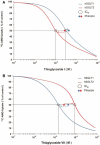Thioglycosides as inhibitors of hSGLT1 and hSGLT2: potential therapeutic agents for the control of hyperglycemia in diabetes
- PMID: 17505558
- PMCID: PMC1868657
- DOI: 10.7150/ijms.4.131
Thioglycosides as inhibitors of hSGLT1 and hSGLT2: potential therapeutic agents for the control of hyperglycemia in diabetes
Abstract
The treatment of diabetes has been mainly focused on maintaining normal blood glucose concentrations. Insulin and hypoglycemic agents have been used as standard therapeutic strategies. However, these are characterized by limited efficacy and adverse side effects, making the development of new therapeutic alternatives mandatory. Inhibition of glucose reabsorption in the kidney, mediated by SGLT1 or SGLT2, represents a promising therapeutic approach. Therefore, the aim of the present study was to evaluate the effect of thioglycosides on human SGLT1 and SGLT2. For this purpose, stably transfected Chinese hamster ovary (CHO) cells expressing human SGLT1 and SGLT2 were used. The inhibitory effect of thioglycosides was assessed in transport studies and membrane potential measurements, using alpha-methyl-glucoside uptake and fluorescence resonance energy transfer, respectively. We found that some thioglycosides inhibited hSGLT more strongly than phlorizin. Specifically, thioglycoside I (phenyl-1'-thio-beta-D-glucopyranoside) inhibited hSGLT2 stronger than hSGLT1 and to a larger extent than phlorizin. Thioglycoside VII (2-hydroxymethyl-phenyl-1'-thio-beta-D-galacto-pyranoside) had a pronounced inhibitory effect on hSGLT1 but not on hSGLT2. Kinetic studies confirmed the inhibitory effect of these thioglycosides on hSGLT1 or hSGLT2, demonstrating competitive inhibition as the mechanism of action. Therefore, these thioglycosides represent promising therapeutic agents for the control of hyperglycemia in patients with diabetes.
Conflict of interest statement
Conflict of interest: The authors have declared that no conflict of interest exists.
Figures




Similar articles
-
Structural selectivity of human SGLT inhibitors.Am J Physiol Cell Physiol. 2012 Jan 15;302(2):C373-82. doi: 10.1152/ajpcell.00328.2011. Epub 2011 Sep 21. Am J Physiol Cell Physiol. 2012. PMID: 21940664 Free PMC article.
-
Inhibitor binding in the human renal low- and high-affinity Na+/glucose cotransporters.J Pharmacol Exp Ther. 2008 Mar;324(3):985-91. doi: 10.1124/jpet.107.129825. Epub 2007 Dec 6. J Pharmacol Exp Ther. 2008. PMID: 18063724
-
Development of a novel non-radioactive cell-based method for the screening of SGLT1 and SGLT2 inhibitors using 1-NBDG.Mol Biosyst. 2013 Aug;9(8):2010-20. doi: 10.1039/c3mb70060g. Epub 2013 May 8. Mol Biosyst. 2013. PMID: 23657801
-
Exploring newer target sodium glucose transporter 2 for the treatment of diabetes mellitus.Mini Rev Med Chem. 2010 Sep;10(10):905-13. doi: 10.2174/138955710792007213. Mini Rev Med Chem. 2010. PMID: 21034414 Review.
-
Sodium glucose cotransporter SGLT1 as a therapeutic target in diabetes mellitus.Expert Opin Ther Targets. 2016 Sep;20(9):1109-25. doi: 10.1517/14728222.2016.1168808. Epub 2016 Apr 12. Expert Opin Ther Targets. 2016. PMID: 26998950 Free PMC article. Review.
Cited by
-
Visible-Light-Mediated Stadler-Ziegler Arylation of Thiosugars with Anilines.ACS Org Inorg Au. 2022 Mar 28;2(4):351-358. doi: 10.1021/acsorginorgau.2c00006. eCollection 2022 Aug 3. ACS Org Inorg Au. 2022. PMID: 36855591 Free PMC article.
-
Transition-metal-free synthesis of aryl 1-thioglycosides with arynes at room temperature.RSC Adv. 2021 Aug 4;11(43):26666-26671. doi: 10.1039/d1ra04013h. eCollection 2021 Aug 2. RSC Adv. 2021. PMID: 35479995 Free PMC article.
-
Emerging treatment options for type 2 diabetes.Br J Clin Pharmacol. 2010 Nov;70(5):631-44. doi: 10.1111/j.1365-2125.2010.03711.x. Br J Clin Pharmacol. 2010. PMID: 20831513 Free PMC article. Review.
-
Forces and dynamics of glucose and inhibitor binding to sodium glucose co-transporter SGLT1 studied by single molecule force spectroscopy.J Biol Chem. 2014 Aug 1;289(31):21673-83. doi: 10.1074/jbc.M113.529875. Epub 2014 Jun 24. J Biol Chem. 2014. PMID: 24962566 Free PMC article.
-
Spotlight on ertugliflozin and its potential in the treatment of type 2 diabetes: evidence to date.Drug Des Devel Ther. 2017 Oct 3;11:2905-2919. doi: 10.2147/DDDT.S114932. eCollection 2017. Drug Des Devel Ther. 2017. PMID: 29042751 Free PMC article. Review.
References
-
- Del Prato S, Matsuda M, Simonson DC et al. Studies on the mass action effect of glucose in NIDDM and IDDM: evidence for glucose resistance. Diabetologia. 1997;40:687–697. - PubMed
-
- Bonadonna RC. Alterations of glucose metabolism in type 2 diabetes mellitus. An overview. Rev Endocr Metab Disord. 2004;5:89–97. - PubMed
-
- Klein R. Hyperglycemia and microvascular and macrovascular disease in diabetes. Diabetes Care. 1995;18:258–268. - PubMed
-
- Haffner SJ, Cassells H. Hyperglycemia as a cardiovascular risk factor. The American Journal of Medicine. 2003;115:6S–11S. - PubMed
-
- Porte D Jr, Schwartz MW. Diabetes complications: why is glucose potentially toxic? Science. 1996;272:699–700. - PubMed
MeSH terms
Substances
LinkOut - more resources
Full Text Sources
Other Literature Sources
Medical

